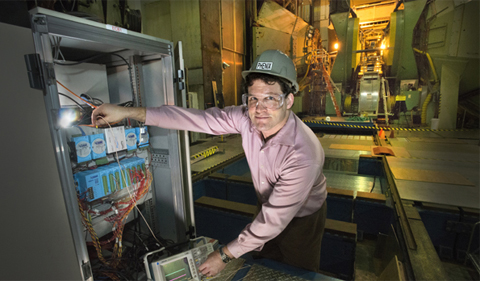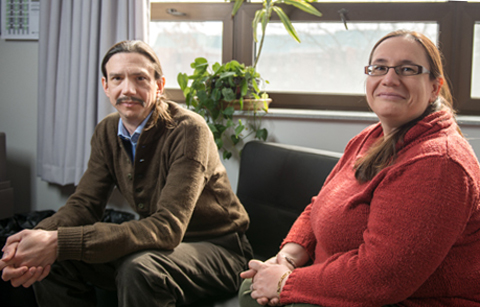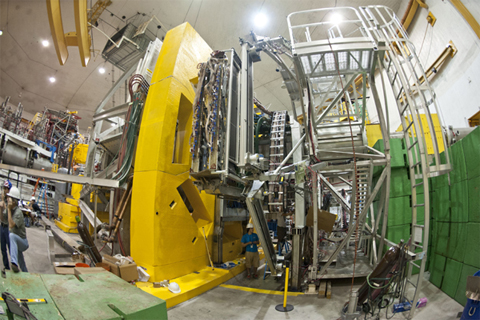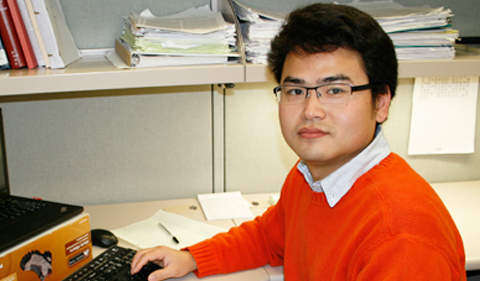As matter “cooks” to 4 trillion degrees Celsius—250,000 times hotter than the center of the sun—protons and neutrons melt into a liquid plasma of quarks and gluons. This liquid may have been present at the start of the universe for a few microseconds. See how Dr. Justin Frantz Catches a Glimpse of a New State of Matter. And read more about his team’s research in the following Perspectives article.
By Sara LaJeunesse
From Perspectives
For people who study such tiny objects as protons, neutrons, quarks, and gluons, particle physicists do things big. They belong to teams of collaborators that comprise hundreds; they work in laboratories that extend for miles; and they generate thousands of terabytes of data. Yet these grand behaviors are not acts of bravado; rather, they are performed out of necessity.
“Our experiments typically run for six months, and during that time, we collect data on billions of events,” says Dr. Justin Frantz, Assistant Professor of Physics & Astronomy at Ohio University, adding that the “events” he studies are collisions of relativistic heavy ions, such as gold atoms stripped of their electrons. “This type of work requires a huge amount of time and expertise. It cannot be done alone.”
Frantz’s experiments are designed to unravel the mysteries of the strong force, one of the four fundamental interactions in nature. Two other Ohio University physicists—Associate Professor Dr. Julie Roche and Assistant Research Professor Dr. Paul King—are examining another of the fundamental interactions: the weak interaction. They also rely on big instruments, big data sets, and big collaborations to answer questions.
The Puzzle of the Quark-Gluon Plasma
It turns out you can learn a lot by smashing particles together. Frantz and his team of about 500 scientists are using the technique to study the strong force, which holds together all the protons and neutrons of the universe.
To investigate this force, the scientists use a facility called RHIC, a more than two-mile-long relativistic heavy ion collider located at Brookhaven National Laboratory in New York. The goal is to break up the ions’ protons and neutrons into their component quarks and gluons. The result is a substance, called the quark-gluon plasma, which Frantz says may exist outside the laboratory at the center of neutron stars and likely was present for a few microseconds just after the Big Bang explosion.
“We’re interested in understanding more about the quark-gluon plasma not only as a way of gaining a better understanding of the strong nuclear force and of what happened in the evolution of our universe, but also because it may even help us improve our basic understanding of quantum mechanics,” he says.
To conduct their experiments, the team uses the PHENIX detector at RHIC to “look” inside the quark-gluon plasma in much the same way that X-rays “look” inside the human body.
“When we first set out to study the quark-gluon plasma, we expected it to behave like a gas; however, we were surprised to find that it behaves more like a liquid,” Frantz says.
The team also was astonished at how quickly the plasma forms, he adds. “We don’t know of any interactions that could drive formation that quickly. There must be some very strong interactions between the particles that could cause it to form into this quark-gluon plasma so fast. That’s one of the leading questions we have right now.”
Much of Frantz’s contribution to the effort is in the form of computer programming.
“We need to collect data on about 10 billion collisions because the quark-gluon plasma that we create in the lab exists for less than a billionth of a trillionth of a second,” he says. “The amount of computing power that’s needed to collect, store, and analyze this data, which is more than 100 terabytes of data a day, is staggering.”
A Ten-Year Quest
Julie Roche and Paul King also deal with vast quantities of data—roughly 120 terabytes in their latest experiment, called the “Q-weak experiment.” Along with a team of about 100 other scientists, Roche and King set out to measure the weak charge of the proton, something that no other physicist had done before.
The weak force acts on subatomic particles. It plays a key role in the nuclear reaction processes that take place in stars and is behind much of the natural radiation present in the universe, according to the U.S. Department of Energy’s Jefferson Lab.
Although the Standard Model of physics predicts the weak charge of the proton, actually measuring it experimentally has been very difficult—until now. That’s because scientists needed advances in technology and incredibly sensitive equipment to be able to detect the tiny variation in the electron scattering rate that would produce the measurement.
Over the course of 10 years, the researchers constructed a special detector at the Jefferson Lab in Virginia. The Ohio University team contributed to the project by designing and installing the data acquisition system and the analysis software. During the two years of data collection, they provided 24-hour on-call support.
In the experiment, scientists directed a beam of electrons into a container of liquid hydrogen, rapidly changing the direction of the electrons’ spin back and forth. The weak charge could be measured based on its unique interaction with the electrons.
So far, the researchers have analyzed four percent of the data they generated.
“Our results agree with the Standard Model prediction, which is not a surprise at this level of precision,” Roche says.
However, once they have the full results, which will be much more precise, the team could see the effects of exotic physics not yet included in the Standard Model of physics, Roche says.
The Standard Model has been useful for understanding physics in the range of energy that scientists have been able to study to date, she explains. However, “the Standard Model fails to explain some important aspects of the universe, such as dark matter, dark energy, and the matter/anti-matter asymmetry.”
The research could complement high-energy searches for new physics discoveries at the Large Hadron Collider in Geneva, Switzerland.
Big Data, Big Teams
Roche believes the full data set will take her team a few years to analyze. In the meantime, she is already planning her next experiment to measure the weak charge of the electron. Although she is eagerly awaiting the results of these experiments, she says she enjoys the process of working with her collaborators.
Frantz, too, values the time he spends with his fellow scientists. Although his team of about 500 individuals is divided into smaller working groups to perform different tasks (an elaborate management structure exists to run the collaboration), the larger group does meet regularly, and Frantz has become well acquainted with each and every one of his colleagues.
“There’s no way I could do this work without their contributions; we all feel that way,” he says. “Besides, everyone knows that they can trust the data we produce because a lot of eyes looked at every single result.”
And that, he adds, is the kind of large-scale teamwork that gets the enormous job of understanding nature’s most fundamental interactions done.
This story appeared in the Spring/Summer 2014 issue of Ohio University’s Perspectives magazine, which covers research, scholarship and creative activity.






















One Comment